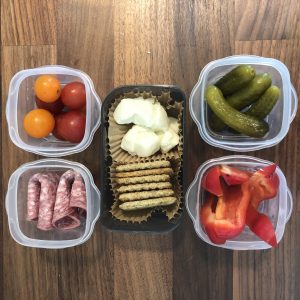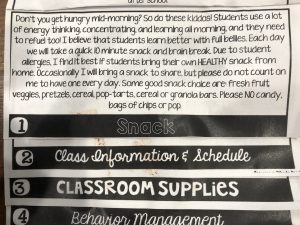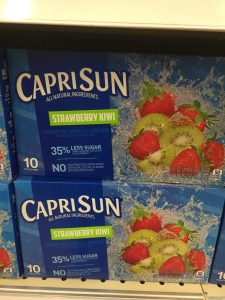What the Lunchbox Challenge Taught Me…

A sample of one of my “new and improved” lunchbox meals made by my two boys during the Lunchbox Challenge.
When I first came up with the Lunchbox Challenge, it was totally selfish.
- I wanted to stop hating the process of making lunches every morning.
- I wanted a way to force myself to get more creative with what I was feeding my kids for lunch everyday.
- I wanted to remove the guilt I felt about the kinds of things that I was packing day-in, day-out.
These “things” weren’t necessarily bad, but when I felt like I was constantly defaulting to “crackers, cheese stick, and an apple” — well.. I began to worry that my kids would never learn to love variety.
As I began to “plan” the challenge, a few interesting observations caught me by surprise.
And in this week’s blog, I wanted to share them with you.
It’s my hope that these observations will inspire you to take the 14 Day Lunchbox Challenge yourself and make your own “a-ha” discoveries.
The Lunchbox Challenge did “change my life.”
My kids now pack their own lunches (with my supervision).
But this shift in responsibility would never have happened without the Challenge.
Here are my big take-aways from the experience, that I broke down into 7 observations.

These are my two boys Josiah (7) and Jed (10), foraging for paw-paws. Yeah… they can totally pack a lunch.
Observation #1: Unbeknownst to me, my kids were ready to pack their own lunch.
This one hit me right between the eyes when I wasn’t looking. And it happened before the challenge even started.
I was sharing my idea for the Challenge with Kathy Pietrowski, one of my friends (and a CSA member), and she proceeded to tell me that her kids had been making their own lunches for quite some time. (Her girls are 11, 9, and 7).
But it was the way she said it that hit me like a ton of bricks — it was like she was surprised that I hadn’t delegated this yet.
It made me ask myself, “Should my kids know how to do this by now? Am I behind the 8-ball? Why haven’t I given this job away to my kids yet?”
And that’s when I noticed observation #2.
Observation #2: I didn’t want to give up this job to my kids yet. I was holding onto it for a reason.
And that reason was because I somehow equate “making my kids lunch” as a way of showing love to my children. By carefully crafting their box with a unique meal, I send a signal to them that Mom cares enough to make a home-made lunch like she would if they were at home.
Problem is: my daily “unique meal” was far from my ideal vision, which is probably why I was beginning to hate making lunches — I always felt like I was failing in this goal.
As much as Kathy’s challenge to start letting my kids make their own lunch rang true… it was hard to let that responsibility go.
It felt like the end of an era.
It meant admitting that my kids were growing up — they didn’t need me as much. They were leaving the childhood phase.
And for a woman who has gathered the wagons around her identity as a stay-at-home mom, this is a hard shift to make.
Observation #3: Letting my kids pack their own lunch was a necessary right of passage.

If my son can ride a lawnmower, there’s no reason he’s not old enough to make his own lunch. Right?
My mom passed away many years ago, and sometimes I feel like I’m flying blind as a parent — relying on my own memories of how I was raised to rear my own children.
Teaching my kids how to make lunch just never fell on my radar. But Kathy was right… it’s a SKILL SET that all kids must learn. And why not now?
When is a child old enough to pack themselves? I’d never really thought about it.
If my boys (age 7 and 10) can drive a Gator around the farm, wield a hot glue gun without burning their hands off, and mow the grass with a riding lawnmower, then they can certainly figure out how to pack their own lunch.
Can I get an Amen?
Observation #4: Packing their own lunch empowered my kids. (BONUS!)
This was something I had not expected. As soon as I decided I would use the 14 Day Lunchbox Challenge to transition/train my boys into being their own Lunch builders, I thought they would whine and complain.
“I don’t want to…”
But the opposite happened.
There was NO resistance. In fact, they thought it was kinda fun — especially when I had some good things to choose from in the pantry inventory (aka jerky and yogurt and oranges) — and new containers to compartmentalize everything into perfect portion sizes.
And more importantly, they ate it all up.
So I watched my role shift from “packer” to “teacher” and “supervisor.” And in that moment, I felt proud and powerful…. like I was fulfilling my role of raising up self-sufficient humans.
Now that the Challenge is over, it’s not all rainbows and unicorns. My boys often have to be nagged several times to make their lunches, but I smile when I see Josiah take down the Lunch Menu Ideas cheatsheet from our fridge and look at it every night — identifying his protein, dairy, veggie and fruit.
I’ve just given him a priceless gift.
Observation #5: It’s our job as parents to teach our kids how to eat the right way.
This is closely related to observation #3. But I think not enough of us see “teaching our kids how to eat” as a life skill we need to be teaching.
Instead we think about things like teaching our kids to read and write, listening to authority, showing good manners, throwing a softball or making their bed.
But do we intentionally train our kids about how to eat well? Are we explaining why soda is a bad idea, or why we don’t want to eat sugary foods, or how we’re training their brain to like certain foods at an early age and why it matters?
Yes, I actually started having these conversations with my kids in the last few weeks… explaining the reasons behind our food choices.
The other day Josiah woke up and headed into the kitchen to find some breakfast. I watched him open up a Tupperware box on the kitchen table that had some chocolate chip bars inside and grab one as if he were going to eat it for breakfast.
“What are you doing?!” I challenged.
He quickly dropped the bar back into the bin.
“No way!” I said. “We don’t eat that for breakfast.”
Before the Lunchbox Challenge, I would have left it at that. But this time, I took a few minutes to explain WHY I had made that declaration.
- Why do we eat certain foods in the morning?
- What does it do for us?
- What happens to our brains when train them to want sugar all the time?
- What are better choices for us in the morning?
- When is a good time to have this sweet snack?
Observation #6: If I want to teach my kids to eat better lunches, then I need to model it myself.
This is why teaching kids how to eat well is so hard. Because I don’t want to do it myself.
And if I’m honest, it’s probably why I have soda and chocolate bar cookies and potato chips in the house.
It’s why I grab easy processed food from the grocery store or drive through McDonalds once a week for french fries. (YES, I DO!!)
I want to eat them.
Because they taste good. Because it’s easy and fast. Because I WANT THEM.
I’m not sure what to do about this. But I do recognize that this is a MAJOR obstacle to fully embracing the “healthy way of eating.”
My CSA members who are rocking it out with this “teaching their kids to eat” gig, are successful because they are personally ALL IN.
Eating well is a discipline and way of life for EVERYONE in the family. The adults don’t get to live by a different set of food rules.
That’s a hard truth… I realized that I have some bad food habits, and because I’m not willing to give them up, they are transmitting onto my kids.
And I need to take full responsibility for it.
Observation #7: We need to partner with teachers and communicate our expectations around food in school.
No big surprise, but there were quite a few stories during the Challenge from some of you, describing how your child brought their lunchbox home, half-eaten or barely touched at all.
This set off a lively discussion in our online group comments as to why this might be happening and how to overcome it.
A few observations surfaced here for me that I thought were worth mentioning:
Tip #1: Our kids may be getting fed a snack in school before lunchtime. Is this a good idea? Talk to your teacher.
I know that Josiah’s 2nd grade teacher sent home a note this year asking us to pack a mid-morning snack in case the kids were hungry. She even gave suggestions for what they could be. (It was actually a good list of snack ideas too).

I got this note from Josiah’s teacher this year. Snack requests are a common thing among most teachers in schools — but are they a good idea? (PS: I love Josiah’s teacher!)
In fact, I’ve gotten this request for every grade in elementary school (except 5th). And before the Lunchbox Challenge I thought nothing of it.
Now I’m wondering if snack time might be part of the problem?
Some grades eat lunch a lot later than others. I know Jed (a fifth grader) is last of the grades to eat. For an older boy, that can be a long time to wait, and hunger may be a legitimate thing. I’m sure teachers are just trying to solve this problem so their kids can focus in class.
What does this mean for you?
If your child isn’t eating your packed lunch, you may want to investigate whether the mid-morning snack is the culprit. Find out if your teacher is offering snack and what TIME the snack is offered. If it’s in the morning pre-lunch, you may want to let your teacher know that you’d prefer your child NOT eat a snack (and explain why).
Tip #2: Change your drink selection. Is your kid filling up on drinks?

Drinks can fill up your little one with unnecessary sugar before they even get started eating…
This never occurred to me until the Lunchbox Challenge either. And it makes total sense.
Whenever we go out to eat at a restaurant, Josiah will down his lemonade within the first 10 minutes while we wait for our meal to arrive.
The result?… He often doesn’t have room to eat his actual meal.
We’ve actually had to institute a “no drinking before dinner rule ” at restaurants as a result.
It’s no different at school.
Your kids are probably thirsty, and when they open their lunchbox, if you’ve provided a tasty drink inside (aka not water), they may very well be filling the well with that beverage.
Tip #3: What would happen if we asked our local school cafeterias to get rid of flavored milk for everyone?…

What if we removed this temptation entirely from our local school cafeterias?…
Would there be a revolt?
I’m just about ready to become a Lunchtime activist for my local school community. This Challenge opened up my eyes to some common practices in our national lunch system that may be seriously setting back our kids.
Here’s why I’m hesitating…
Having served on a local school board once, I know how much of board business and resources gets taken up with issues that have little to do with actual classroom instruction, and so the last thing I want is to draw attention to an issue that doesn’t move the pawn forward academically.
But at the same time, school lunch menu decisions are (in a way) a form of education. It’s training our kids how to eat.
I just wonder… what would happen if we advocated for a system that made it hard for kids to access processed food for lunch?
- Would we see better focus in class?
- Would it reduce behavior issues?
- Lower health risks and child obesity rates?
- Greater self-esteem?
That’s a big “if”, but I feel like one baby-step in the right direction might be to tackle a small piece of the problem and just get flavored milk out of our schools.
Sigh…
It’d probably just piss off a bunch of parents.
Anyway… I bring it up here as a final “Hail Mary” kind of challenge.
I may just find the courage to bring it up in my community this fall. If it goes no where, so be it. But perhaps you’ll be inspired to make this request too, and we can all make a small impact on our greater school community for the better.
Thank you, Lunchbox Challenge, for opening my eyes to so many things I never expected, giving me a kick in the pants, and helping me finally launch my kids into a new stage of food responsibility.
Now I’m going to go eat some potato chips while no one is looking…
(I’m KIDDING!!!)
To do the 14 Day Lunchbox Challenge, I encourage you to download our Lunchbox Menu Ideas template below. This will automatically start a 14 Day email series that will coach you through your own challenge and share some tips to help you. Good luck!
